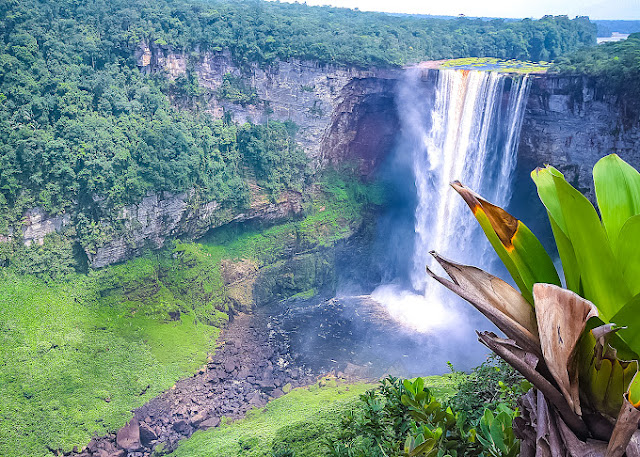10 Fascinating Facts About the Kaieteur Falls
10 Fascinating Facts About the Kaieteur Falls
Kaieteur Falls is one of the most stunning natural wonders of Guyana, South America. It is a must-visit destination for nature lovers, adventure seekers, and anyone who wants to witness the breathtaking beauty of nature. In this article, we will explore ten fascinating facts about the Kaieteur Falls that will leave you in awe.
1. The Location of the Kaieteur Falls
The Kaieteur Falls is located in the Potaro-Siparuni region of Guyana, South America. It is situated in the Kaieteur National Park, which covers an area of approximately 63 square miles. The park is accessible only by plane or by foot, making it a remote and untouched destination.
2. The Size and Height of the Kaieteur Falls
The Kaieteur Falls is one of the tallest single-drop waterfalls in the world, with a height of 741 feet. It is five times higher than Niagara Falls and two times higher than Victoria Falls. The width of the waterfall is approximately 370 feet, making it one of the widest waterfalls in the world.
3. The Origin of the Name Kaieteur
The name Kaieteur is derived from the Patamona tribe's language, the indigenous people of the region. Kaieteur means "old man" or "old man's place," referring to the legend of the tribe's chief who sacrificed himself to the Great Spirit Makonaima by jumping off the waterfall.
4. The Formation of the Kaieteur Falls
The Kaieteur Falls was formed around 5 million years ago when the Potaro River eroded the sandstone and conglomerate rocks, creating a deep gorge. The waterfall is located at the edge of the gorge, where the Potaro River drops off a cliff into a pool below.
5. The Flora and Fauna of the Kaieteur National Park
The Kaieteur National Park is home to a diverse range of flora and fauna, including over 800 species of plants, 400 species of birds, and numerous species of mammals, reptiles, and amphibians. Some of the unique species found in the park include the giant otter, the jaguar, the golden frog, and the cock-of-the-rock bird.
6. The Cultural Significance of the Kaieteur Falls
The Kaieteur Falls is a significant cultural site for the indigenous people of Guyana. It is believed to be a spiritual place and is often used for sacred rituals and ceremonies. The waterfall is also a symbol of national pride and has been featured on the country's currency and postage stamps.
7. The Tourist Attractions near the Kaieteur Falls
The Kaieteur Falls is not the only attraction in the Kaieteur National Park. Visitors can explore the park's hiking trails, which offer stunning views of the rainforest and the Potaro River. The park also has several other waterfalls, including the Amatuk and the Waratuk Falls, which are worth visiting.
8. The Geological Importance of the Kaieteur Falls
The Kaieteur Falls is an essential geological site as it provides scientists with insights into the region's geological history. The waterfall exposes rocks that are over 2.5 billion years old, making it one of the oldest sites in the world. The rocks found at the Kaieteur Falls are significant in understanding the evolution of the Earth's crust and the formation of the continent of South America.
9. The Threats Facing the Kaieteur Falls
Despite its remote location, the Kaieteur Falls faces several threats, including deforestation, mining, and pollution. Deforestation and mining activities have caused soil erosion, which can lead to landslides and damage the natural habitat of the flora and fauna in the park. Pollution from human activities and agricultural runoff can also harm the quality of the water in the Potaro River.
10. The Conservation Efforts for the Kaieteur Falls
To protect the Kaieteur Falls and its surroundings, the Guyanese government has established the Kaieteur National Park, which has been designated a UNESCO World Heritage Site. The park is managed by the Guyana Protected Areas Commission, which is responsible for monitoring the park's ecosystem, enforcing regulations, and promoting sustainable tourism. The commission has also partnered with local communities to promote conservation and sustainable livelihoods.
In conclusion, the Kaieteur Falls is a remarkable natural wonder that is not only breathtaking but also holds significant geological, cultural, and ecological importance. As travelers, it is our responsibility to ensure that we visit and experience the Kaieteur Falls in a sustainable and responsible manner, leaving no negative impact on this unique and fragile ecosystem.
FAQs
1. Can you swim in the Kaieteur Falls?
- No, swimming is not allowed in the Kaieteur Falls due to the strong currents and dangerous rocks in the pool below the waterfall.
2. How do you get to the Kaieteur Falls?
- The Kaieteur Falls is accessible only by plane or by foot. Visitors can take a flight from Georgetown to the Kaieteur Airstrip, followed by a short hike to the waterfall.
3. Is the Kaieteur Falls safe to visit?
- Yes, the Kaieteur Falls is safe to visit as long as you follow the park's rules and regulations and practice responsible tourism.
4. What is the best time of the year to visit the Kaieteur Falls?
- The best time to visit the Kaieteur Falls is during the dry season, which runs from September to November and from February to April.
5. Is there an entrance fee to the Kaieteur National Park?
- Yes, there is an entrance fee to the Kaieteur National Park, which is used to fund conservation efforts and the park's maintenance.


Post a Comment for "10 Fascinating Facts About the Kaieteur Falls"